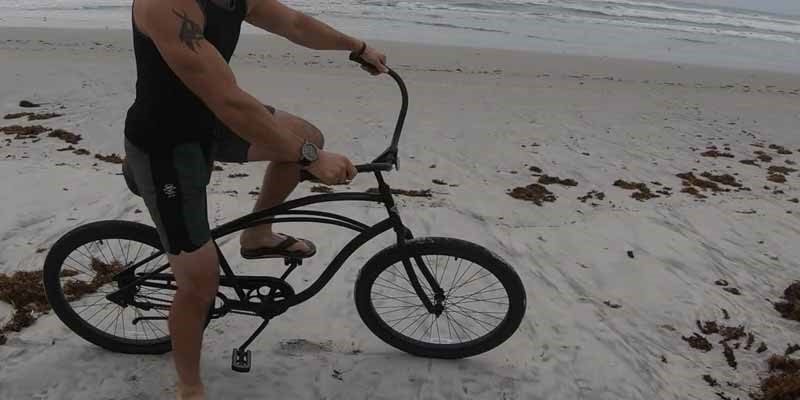Today we’re going to talk about beach riding, like actual sand riding on the beach, and talk a little bit about beach cruisers and do beach cruisers work on the sand.
A beach cruiser is sort of a name for a bike in the idea that you can cruise by the beach. But generally speaking, beach cruisers are not for the sand or cannot be ridden on the sand. So here we explain what’s going on.
Tires of Beach Cruiser Bikes
The tires generally on a beach cruiser are 2.1, two, five inches, and now if you’re riding really close to the ocean or the water on hardpack sand, usually like kind of the wet thicker hardpack.
You can ride a bike on that and you could ride a best beach cruiser bike on that. However, beach cruisers are not designed to be ridden on the sand and now with that said, riding on the sand.
There are some new bikes that have come out. The fat-tire bikes have about three and a half-inch or four-inch tires that are really thick.
These are bikes that actually can be written on the side and, but I will say one thing now I’ve tried to ride those bikes in a very loose, soft sort of hilly track but like sand, where there are like and little bumps and things like that.
That can be challenging. So not all bikes, even those fat tire bikes can not necessarily be written on very, very loose sand.
You are going to want a pretty, you know, easy and smooth surface, and the harder pack, the better again, fat tires can do it, but definitely still going to be challenging.
I just want to make sure, you know, if people are looking at beach cruisers, they don’t get this idea in their head that a beach cruiser can perform on the sand, you know, beach cruisers are like a normal bike.
It’s just sort of a category, just like an SUV is to a car and in this day and age, a beach cruiser can be designed like any other and it’s really capable of riding or doing something of the same things as other bikes you know, it doesn’t have to be just used by the beach.
That’s sort of just, you know, again how they came to be in the name they work. So, if you are looking to ride on the sand, look out for a four-inch fat tire bike.
I would say preferably gears, like a seven-speed and above that’s going to give you, you know, some easier pedaling allow you to maybe do some more of the bumpier sand, so you don’t have to stay as close to the water on the hard pack sand.
Pedal Assist of Beach Cruiser
One impression that I’ve gathered from events and bikes as a whole is they’ve always done a very good job, creating a true pedal assist level one and a level five. So, what does that mean? It means pedal assist level one.
It’s barely helping you. In fact, it really feels like it’s just taking away that additional weight, the motor, and battery, add to the bike to make it really ride like a standard bicycle.
And then a true pedal assists level five setting on this bike means this bike is doing everything it can to get you as close to that class.
Three speeds of 28 miles per hour as it can, you’re going to be going very fast and as you saw in our range test, we got 23 miles per hour on our average speed.
So, when it comes to pedal assist, level one and I got just below 15 miles per hour, which is about two miles per hour, faster than this bike turned completely.
When it comes to this bike in its highest pedal assist level, I got 25.4 miles per hour on average, around our circuit tests.
So essentially what I have gathered is you’re going to be able to go at that leisurely pace very easily and you’re going to be able to go very fast if that’s what you want to do to the event in has made it very easy to look at all your different pedal assist settings on your LCD display here.
This display is adjustable, forwards and backward, and it’s going to show you pretty much everything that you need to know on your ride.
You have your miles per hour, current pedal assist level. Trip miles, total miles, and battery life. Now I would like to see a wattage meter on future models, but I’ll get more into that later.
You can control all of those settings on your little control panel here that allows you to go up or down in pedal assist.
Actuate some of those odometer settings and turn the bike on and off next to that, you have a lever throttle that gets you up to 20 miles per hour.
I find this throttle engages very smoothly to where you can tell there is power behind the bike, but it’s not going to show off and blow you off the back of it.
you can already tell it’s working harder. That makes sense. I’m not peddling with the bike or approaching the steepest part of the hill. Now around 11 miles per hour can definitely hear the motor working, but we’re still moving decently. I think we’re going to make it all right now we’re around eight miles per hour.
This is where it’s usually really hard for these bikes. Not all of them make it, but it looks like this event and pastes 500 steps through probably.
So, what I’m really gathering is if you don’t want to work hard, when you’re climbing up a steep hill, you don’t really have to right.
It’s rare Hills, get any steeper than that and your motor and battery. We are going to thank you if you help. But if it’s been a long day, you’re headed home from work and you just don’t want to peddle, but you rode the bike.
Conclusion
So, hope that the articles help you to get the right information and If you have any questions, comments, or ideas to throw in the below comments, and if you are interested in more biking premium content you can visit OutdoorXsports and it’s really an outstanding web blog.

